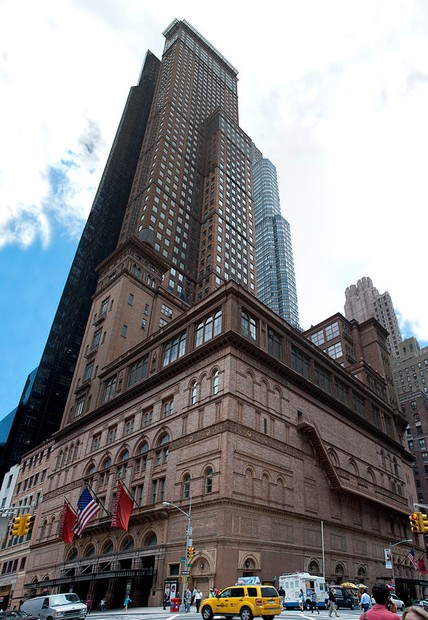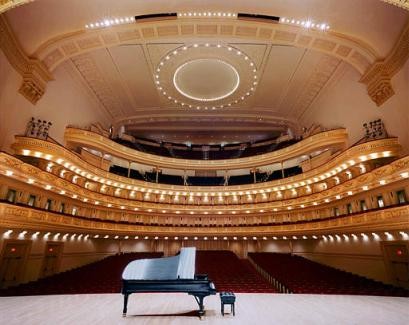Carnegie Hall
Introduction
Text-to-speech Audio
Designed by architect William Burnet Tuthill and built by philanthropist Andrew Carnegie in 1891, Carnegie Hall remains among the most famous and prestigious venues in the world for both classical music and popular music. Carnegie Hall has its own artistic programming, development, and marketing departments and presents about 250 performances each year. Visitors can tour the building and also visit the Rose Museum which preserves and presents the history of the venue.
Images
New York's Carnegie Hall

Carnegie Hall's grand theater- one of several stages in the venue.

Backstory and Context
Text-to-speech Audio
Carnegie Hall was funded by a man named Andrew Carnegie, who the building would be named after later on. It was originally intended to be a building only in use by the Ontario Society of New York and the New York Symphony Society, whose boards Carnegie served on. The construction of the venue started in 1890 and it was carried out by the Isaac A. Hopper and Company. The building was in use in April 1891, but would not have its first performance night until May where composer Walter Damrosch and Russian composer Pyotr Ilyich Tchaikovsky performed for the crowd. The Carnegie Family owned the venue until 1925 when Andrew’s wife sold it to a real estate developer named Robert E. Simon. When Simon died, his son would take ownership of the venue in 1935.
Robert E. Simon Jr. ordered for renovations to the Hall in 1947 carried out by the Kahn and Jacobs firm. However, in the 50s, changes in the music industry caused Simon Jr. to sell the venue to another owner. Simon Jr. wanted the New York Philharmonic group to become the new owners, but they were set to move to the Lincoln Center which created conflict. Simon Jr. threatened to terminate the lease to Carnegie Hall in 1959 which ended up happening. The Philharmonic group moved to the Lincoln Center and Carnegie Hall would be set to be purchased by the Glickman Corporation. The corporation wanted to demolish the building in order to build a skyscraper in it’s place, but funding money didn’t come through and delays in construction promoted Glickman to not buy Carnegie Hall.
Simon Jr. asked some of the performers and musicians that notably resided in the Hall for their assistance in saving Carnegie Hall. There was a unanimous decision made that the best course of action was to get the city government involved in this matter. Legislation was passed by the city council and signed by Mayor of New York City Robert F. Wagner Jr. that let the government buy the building for $5 million. The city government then leased the hall over to the Carnegie Hall Foundation in order to help run the venue. It would be designated as a historical landmark in 1962.
From there, a man named James Polshek would help give the venue renovations in 1986 and 2003. He is most notable for the construction and design of his post-modern planetarium at the American Museum of Natural History. During the renovations, many more halls and the creation of a Rose Museum would be added on to Carnegie’s main hall. The New York Philharmonic group had made plans to return to Carnegie Hall in 2003, but they fell through and never came to fruition. In 2014, Carnegie Hall officials added a Judith and Burton Resnick Education Wing , which was large enough to hold an entire chorus or orchestra.
Cite This Entry
Donavon, Martin et. al. "Carnegie Hall." Clio: Your Guide to History. June 19, 2021. Accessed March 20, 2025. https://theclio.com/tour/1799/10
Sources
“Carnegie Hall Then and Now,” Carnegie Hall. Accessed April 29th, 2017. http://www.carnegiehall.org/Article.aspx?id=4294968156.
”About Carnegie Hall,” Carnegie Hall. Accessed June 7th, 2021. https://www.carnegiehall.org/About

